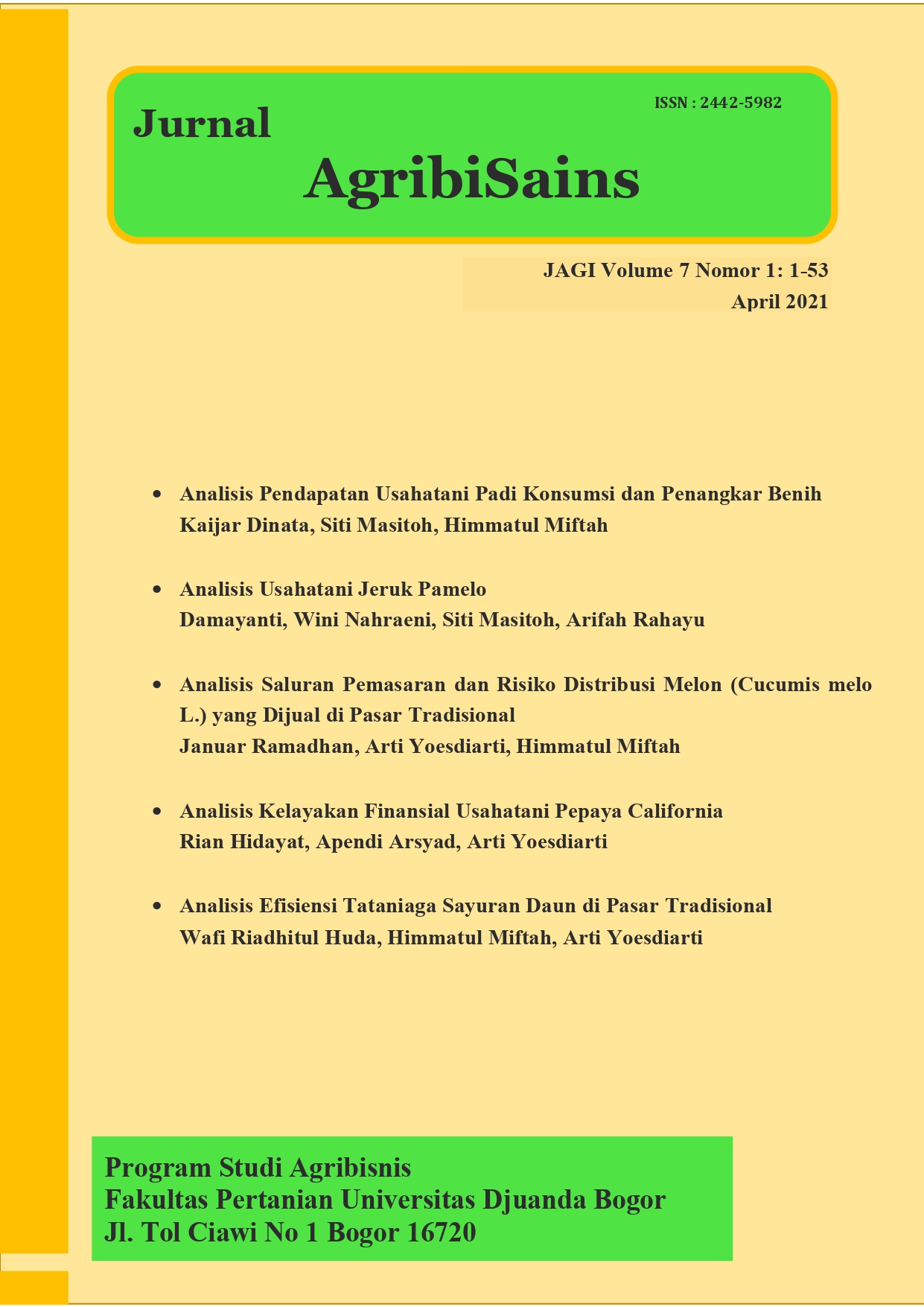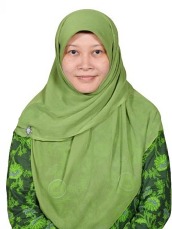ANALISIS EFISIENSI TATANIAGA SAYURAN DAUN DI PASAR TRADISIONAL
DOI:
https://doi.org/10.30997/jagi.v7i1.4553Abstract
Vegetables can be in the form of plants or parts of plants that are consumed fresh or ripe as part of the diet. There are very diverse types of vegetables in the form of tubers, fruit, flowers or leaves. Leaf vegetables are the type most consumed. 97.29% of the Indonesian population consumes vegetables, the types of vegetables consumed by the Indonesian population are leaf vegetables such as kale, chicory and caisim. The purpose of this research is to analyze the efficiency of trading channels and marketing functions carried out by each marketing actor in the Bogor City Traditional Market by using trading margin, farmer share, profit ratio and R / C cost. This research was conducted on the trading channel actors in the Traditional Market in Bogor City. The number of respondents in the study were 15 farmer respondents and 42 merchant respondents from both markets. The data analysis used purposive method for lapak traders and snowball sampling from retailers to farmers. The results of this study were four leaf vegetable trading channels in the Traditional Market of Bogor City with the efficiency level of the three vegetables considered to be the most efficient, namely channel IV on kale vegetables, channel II on chicory and channel IV on caisim, with each having a margin of yield of 3500, 800, 700 and the highest farmer's share was 82.93%, 81.40% and 59.52%. Thus it is necessary to do more analysis related to the strategy of developing vegetable commodities of kale, chicory and caisim in traditional markets related to marketing activities.
References
Abas, M.Z., Zakaria F. dan Pembengo W. 2014. Pertumbuhan dan Hasil Tanaman Caisim (Brassica juncea L)berdasarkan variasi jarak tanam dan varietas. Diunduh tanggal 17 Juni 2015.
Aziz. 2013. Analisis Efisiensi Tataniaga Komoditas Manggis (Studi Kasus di Desa Karacak Kecamatan Leuwiliang Kabupaten Bogor) [Skripsi]. Departemen Ekonomi Sumberdaya dan Lingkungan. Fakultas Ekonomi dan Manajemen. Istitut Pertanian Bogor. Bogor.
Asmarantaka, dan Winandi,R. 2009.Tataniaga Produk-Produk Pertanian. Bunga Rampai Agribisnis Seri Tataniaga. Departemen Agribisnis. Fakultas Ekonomi dan Manajemen. Institut Pertanian Bogor. Bogor.
Badan Pusat Statistik. 2015. Jenis Tanaman Sayuran di Provinsi Jawa Barat Tahun 2014-2015. Http://www.bps.go.id. Diakses 04 Januari 2017.
Badan Pusat Statistika. 2016. Statistik Daerah Kota Bogor 2016. http://www.bps.go.id. Diakses 8 Mei 2017.
Behrman, kliegman, dan Arvin.(1996). Ilmu Kesehatan Anak. Jakarta: Buku Kesehatan EGC.
Djuariah, D. 2007. Evaluasi Plasma Nutfah Kangkung di Dataran Medium Rancaekek. Jurnal Hortikultura. 7(3):756-762.
Downey, W.D dan Ericson. 1992. Dasar-Dasar Manajemen. Terjemahan. Jakarta. PT. Erlangga.
Dirjen Hortikultura Kementrian Pertanian Republik Indonesia. 2015. Keragaan Pengembangan Hortikultura BAB III. pdf. http://hortikultura.pertanian.go.id. Diakses pada 26 April 2016.
Gultom, HLT. 1996. Tataniaga Pertanian. USU Press. Medan.
Hariry, A. 2015. Analisis Tataniaga Ubi Jalar di Desa Purwasari, Kecamatan Dramaga, Kabupaten Bogor [Skripsi]. Program Studi Agribisnis. Fakultas Sains dan Teknologi. Universitas Islam Negeri Syarif Hidayatullah Jakarta. Jakarta.
Haryoto. 2009. Bertanam Kangkung Raksasa di Pekarangan. Kanisius. Yogyakarta.
Haryanto, E., dkk 2005. Sawi & Selada. Penebar Swadaya. Jakarta.
Herawati. 2012. Analisis Tataniaga Nenas Palembang (Kasus Desa Paya Besar, Kecamatan Payaraman, Kabupaten Ogan Ilir, Provinsi Sumatera Selatan). Skripsi. Fakultas Ekonomi Manajemen. Institut Pertanian Bogor. Bogor.
Downloads
Published
How to Cite
Issue
Section
License
Copyright (c) 2021 JURNAL AGRIBISAINS

This work is licensed under a Creative Commons Attribution-ShareAlike 4.0 International License.
Authors who publish with Jurnal AgribiSains agree to the following terms:
- Authors retain copyright and grant the journal right of first publication with the work simultaneously licensed under a Creative Commons Attribution Share-Alike 4.0 International License that allows others to share the work with an acknowledgement of the work's authorship and initial publication in Jurnal AgribiSains.
- Authors are able to enter into separate, additional contractual arrangements for the non-exclusive distribution of the journal's published version of the work (e.g., post it to an institutional repository or publish it in a book), with an acknowledgement of its initial publication in Jurnal AgribiSains.
- Authors are permitted and encouraged to post their work online (e.g., in institutional repositories or on their website) prior to and during the submission process, as it can lead to productive exchanges, as well as earlier and greater citation of published work.









